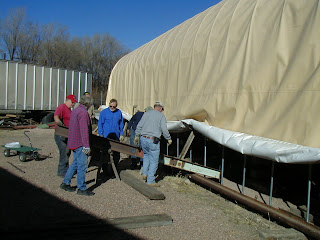John kindly took a picture of me sanding the frames prior to glueing the blocks in place. There was some residual of the hide glue used initially that was removed, as well as roughing the surface for better adhesion. The grooves for the blocks can be faintly seen in the vertical member of the framing to my left.
In this photo, Bob is cutting the blocks to fit. There was some variation in size of the openings, as well as shape where the angled braces are located.
The blocks were both nailed and glued in place, with glue placed around the periphery as on the small triangular blocks stacked below.
This photo (taken by John) shows the blocks in place from the inside of the car. Originally they were only glued, not nailed.
Meanwhile Lenny, John, Tom, and Glenn were involved with steel issues, preparing for securing the steel pieces to the inner sills. Here Lenny is doing some measuring near the splice in one of the inner sills.
Tom S. has been busy fabricating a prototype assembly for fastening the inner sills together. John and Glenn are evaluating the device, and it looks like Tom is on the right track. The bolts are 3/4 X 18-1/4 heavy hex bolts inside schedule 80 pipe which should secure the sills together.



















































